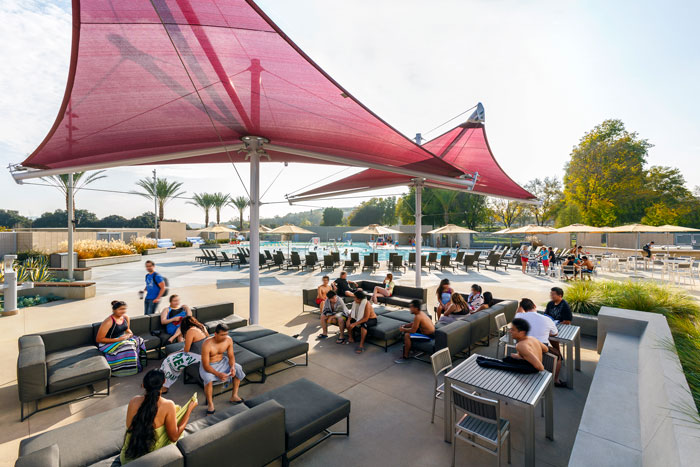Pool operators are always looking to attract new visitors and demographics, and there are many enticements they can add to their product arsenals to help with this mission. These accessories might also allow for adding additional programming and revenues. From simple additions like water basketball hoops and chaise lounges to pool bulkheads and large waterslides, these products allow for some added pizzazz without having to break the bank on major renovations.
“Not only are clients looking to improve their facilities from an aesthetic standpoint, they’re exploring ways to create a more memorable experience for their guests that will translate to return visits,” said Scott Palmer, marketing director for Aquatic Design Group, which offers design and consulting services within the aquatics industry. “The Experience Economy is a driving force for more and more aquatic amenity offerings; obstacle courses, climbing walls, zip lines, shade, cabanas, etc., are becoming the norm.”
Add Some Fun!
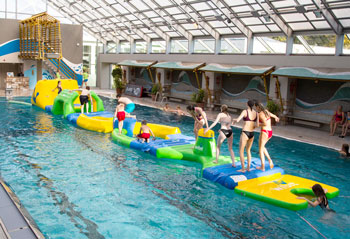
Let’s dive right in to the recreational amenities, as many pool visitors are looking to add some excitement to their swim. “Municipalities are recognizing that more ‘fun water’ amenities or programs offered can help with increasing revenues,” said Palmer, who mentioned the aquatic ninja-style obstacle courses as a current trend, which can be used for recreation, fitness or competition.
These retractable systems can be mounted to ceilings indoors, while outdoors they utilize a deck-mounted truss system. “This takes a unique, new aquatic program that allows for temporary or permanent use. You can offer Masters Swim in the morning, water aerobics mid-morning, then lower the (obstacle course) and you’ve immediately transformed your pool into a fun, recreation experience. The same can be said for climbing walls, stationary waves, water volleyball or basketball, etc.”
Indeed, simple water games can be a big draw and easy add-on. Basketball hoops can mount to concrete pylons, walls or decks, and many can be easily removed from their anchors and replaced with anchor caps. “They’re definitely a mainstay and easy items for your traditional commercial pool to add an extra layer to your open swim programming hours,” said Elliot Ball, commercial product manager of a Canby, Ore.-based manufacturer of commercial and residential pool equipment.
Pool climbing walls are also easily installed, and the see-through, four-foot modular panels can reach 16 feet high, depending on pool depths. Jake Godinez, regional sales manager for a Missoula, Mont.-based manufacturer of commercial pool equipment, said these make great pool features, especially for older facilities where the pool isn’t deep enough for some other features. “Because they’re deck-mounted, (the climbing wall) is also perfect for new builds and existing pools. This product line continues to grow in popularity, geared for all ages.”
Diving boards, stands and towers are still a popular amenity, according to Palmer, not only to accommodate local dive teams, but also for the community at large. “Who doesn’t like nailing a back flip or the tried-and-true, old-fashioned cannonball? On the flip side, there are communities that don’t put in diving boards due to potential risk.”
Godinez agreed that diving boards are still popular for both competition and recreation, and pointed out that pools are being built with deeper diving wells. “We’re gaining traction with the… stainless-steel stair-type dive stands. Aquatic designers like these because they provide a wide, safe way to enter the diving board.”
Added Ball, “Diving is still viewed as an aspirational achievement for both young and old to climb up and either face their fears or challenge their skills.”
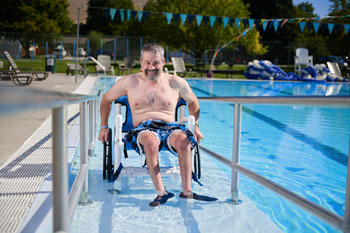
Waterslides are an example of a waterpark-style amenity that pools are adding, available in an array of configurations and colors. There are open or closed flume options, with single or multiple slides, featuring ladders or stairs. “Facilities are always looking for features to bring excitement and revenue, and slides certainly fall into that category,” said Godinez. “These are wonderful for both new construction and retrofit applications for existing facilities.”
Ball added that for existing facilities with limited deck space, “upgrading the pool with deck-mounted slides or any other game-type feature is an easy way to spruce up the pool offering.”
Inflatable play features are also popular, and the modular, interlocking products can be configured into floating obstacle courses, dive stands and more. These amenities can be placed in the water for parties or open swim programming.
“Commercial pool inflatables are increasingly popular for pool operators, helping solve the challenge of providing programming and entertainment options for family activities, team-building exercises, fitness classes and more,” said Sandy Bock, marketing director for a Louisville-based supplier of commercial pool equipment and products. “Innovative inflatables designed for all ages, fitness levels and cultures engage more visitors and provide them an experience they’ll never forget.”
“The beauty of a lot of these new program offerings are their temporary nature,” said Palmer. He explained how, for example, a facility could set up an obstacle course or climbing wall in one pool area while other programs are occurring simultaneously. Then when those programs are done, they can easily be removed and moved to a secure location to make room for the next program. “The more programs offered will not only draw patrons but also new guests who wouldn’t typically venture out to an aquatic facility.”
Comfort & Style
Pool furniture is another area that continues to evolve, with myriad choices of deck chairs, chaise lounges and even sofas, loveseats and rocking swivel chairs for higher-end applications. “Over the years, we’ve noticed pools in commercial settings putting more emphasis on style and types of furniture they offer their patrons,” said Meagan Deacon, marketer with a Lexington, Va.-based vendor of commercial outdoor park and pool furnishings. She said they educate their clients on the differences between commercial-grade versus residential-grade furniture.
The pool furniture is manufactured in a variety of commercial-grade materials, according to Deacon, and their most commonly purchased offerings feature aluminum frames. “These are available with either vinyl straps or fabric slings. They’re built to last, require little maintenance and are easily moved around the pool deck.” They’re also stackable for easy storage.
In addition to seating, “we consistently sell fiberglass or acrylic-top dining tables to our pool customers,” said Deacon. “The chairs for these can be manufactured to match all of our lounge chair options. These tables are also manufactured with an umbrella hole as an option for shade around the pool deck.”
And she said there’s been more customers purchasing coated metal picnic tables and benches for pool use. “The benches are used in the bathroom or shower area, and the tables are used in designated areas for picnics around the pool.”
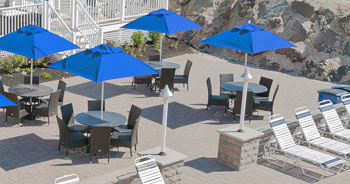
And while their cabanas are typically used on beaches, they’re also showing up on some pool decks, offered as a standard option and also “being used as upgrade options requiring a reservation and additional fee.”
Ball described a variety of in-pool furniture, both portable and installed. “With the rising trend of building either zero-entry or sun shelves into pools, a quick and simple way to elevate the offering is to have portable furniture.”
He explained that their loungers are relatively light and don’t require filling with a hose to keep from floating. “Our system is a series of holes and snorkel-type holes on the underside of the loungers that allows you to set the chair in the water and it naturally fills and can be drained without any additional activity or straining on pool staff or patrons.”
He mentioned the trend of putting pools in stadium clubs or beer gardens for watching live sports, and said this is another use for the in-pool furniture with permanent stools and tables. “Similarly, there are facilities combining water activities with live sports or movies, so creating permanent seating may be an option rather than just the traditional dive-ins with only floaties.”
Palmer said, “You can never have too much shade at an outdoor aquatic facility as we are constantly hearing from clients who wish they had more. The more deck amenities a facility can provide not only helps with the guest experience, it can serve as a reason for that patron to come back again and again.”
Deacon’s company offers many shade and umbrella options, and she said they’ve seen an uptick in those looking to purchase cantilever-style umbrellas, where the cantilever is offset from the pool. “They can be surface-mounted to the pool deck and are a sturdy option for providing shade without the obstruction of multiple posts. Because they come in a variety of sizes, this shade option cuts down on the number of smaller umbrellas to maintain.”
In addition to elevated pool furniture, necessities like pool ladders and rails are also becoming more stylish. “Rails are both functional and beautiful,” said Godinez. “They’re used by aquatic designers to accent the pool. We’re seeing more requests for different stainless-steel materials as well- square, rectangular, flat bar.” He added that their popular custom rails are great for complex, unique site-specific solutions.
Ball said they’ve had much success with their designer series rails. “Many of the rails in this style are designed to be exact replacements for existing rails and retrofit into the existing anchors.” He added that while there’s a trend to elevate commercial pools on new builds to look more modern and stylish, the designer rails also allow existing facilities to “quickly upgrade the visual aesthetic without having to rip up the deck or make any major changes.”
Accessibility, Fitness & Therapy
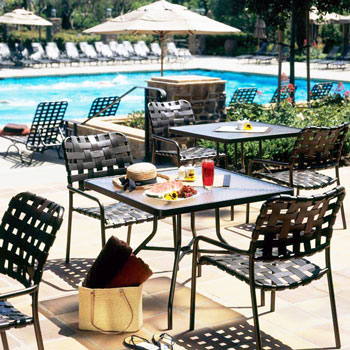
Access amenities are crucial considerations if facilities want to be truly inclusive. After the Americans with Disabilities Act (ADA) was revised to specify pool access in 2012, pool lifts saw a major boom, according to Marley Cunningham, director of marketing for a Missoula, Mont.-based company that designs and builds recreation, fitness and ability-enhancing equipment, including pool lifts. And while there have been major improvements to lifts in terms of overall performance and appearance, she believes their evolution must continue, and explained how they’ve been “developing new technologies and customizations to offer a product that satisfies the needs of both end-users and pool professionals.”
Added Godinez, “As technology advances, we continue to upgrade the components on our lifts to make them as reliable and robust as possible.”
Cunningham explained that they developed the first ever solar charger for pool lifts. “When we realized some of our customers were struggling to maintain their batteries, we developed solar chargers to help with that. We’ve definitely seen a major increase in demand for these products, as they help tremendously with the maintenance of the lead-acid battery that powers our lifts. These types of batteries like to stay charged, and will die if left depleted. The solar chargers have been a wonderful solution for that.”
Cunningham said they started offering custom colors and hand-mixed granite textures in their plastics after architects said they desired something that blended in with their projects more. “Especially in facilities with strong branding, whether it’s a franchised recreation facility or in a post-secondary educational setting, inclusive branding is a major trend to keep your eye on.”
And while many facilities are designed with painstaking detail, incorporating custom colors and branding, she said they often fall short on their access points. “Putting equal effort into the design of your access points sends a loud message to your community, and those who put forth little to no effort send just as loud of a message.”
She described some facilities even removing pool lifts from marketing photos because they think they’re ugly. “People with disabilities represent the largest minority in the world, with incredibly immense buying power. By not advertising their accessibility, they’re losing that business.”
Access chairs are another way to include more people in water activities. “With the emergence of zero-depth entry pools, pool access chairs have become just as necessary as a lift,” said Cunningham, who pointed out that a person’s daily wheelchair is certainly not meant for water use.
Additionally, “Products like the aqua walker are utilized often in therapy for aging adults needing balance training, as well as those recovering from orthopedic or spinal cord injuries.”
There are also access ramps, therapy steps and ladders available for those with physical challenges.
“Fitness and therapy products are growing in popularity as generations of people grow older and are seeking alternative options for exercise that doesn’t include a lot of impact on their body,” said Palmer.
Cunningham’s company offers aquatic bikes, which are gaining popularity with the emergence of aquatic cycling group classes, she said. “These bikes are now being made with adjustable resistance more similar to spin bikes. (Our) pool bikes come with options like a recumbent seat attachment for lower-impact movement and a training bar for added exercises.”
Be Competitive
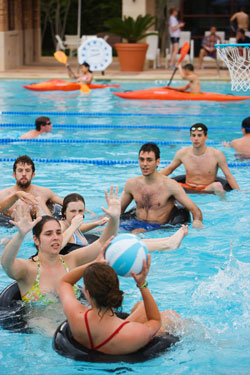
Aquatic Design Group
Competitive pool products are also becoming more widespread. “We’ve seen several recreational facilities adding competitive equipment so that the athletes have access to competitive training and timing components,” said Rick Connell, vice president and general manager of a Loveland, Colo.-based company providing athletic facilities with timing, scoring and display systems. “Additionally, more recreational facilities are equipping their pools so that they can host competitive meets. We’re seeing more facilities sharing/renting space to provide access to water for athletes at all levels.”
And products such as scoreboards can have uses beyond competitive events. “Any pool can benefit from the use of an LED video scoreboard/display,” said Connell. “These units can provide timing data as well as advertising and public service announcements at a reasonable price.”
Ball said that since the pandemic, competitive swimming is growing rapidly, both with USA Swimming and community-level clubs, which will only increase with the upcoming Olympic trials and Olympics. “Because of that growth, our starting blocks are on the rise because athletes are demanding the best to prep for these Olympic cycles.”
He described a big trend of schools partnering with community, YMCA or club facilities, sharing pool privileges. “Because of these partnerships, the facilities have to be prepared for school-sponsored racing in addition to typical community programming, thereby necessitating elite-level starting blocks at facilities that may not have considered it before.”
Diversify!
Traditional bulkheads are mainstays at competition pools, according to Ball, allowing for quick transitions from short to long courses or separating water polo in just minutes. “Facilities are also getting more creative in how they can use bulkheads to separate team and public activities to generate more programming and thus revenue.”
He said swim walls are the next wave of pool programming enhancement because they’re suitable for smaller or non-competition pools as well, “separating the water into something like open swim for kids on one side of the divider and traditional public lap lane swimming on the other side.”
We’ve discussed how pool accessories can facilitate multiple programming options for facilities. Different products can provide and enhance recreation, comfort and style, accessibility, fitness and therapy and competition. And our final amenity can help facilities save money and energy: pool covers and pool cover winding and storage systems.
“Operating a swimming pool is expensive, and thermal pool covers are one of a very few ways to recoup costs associated with running a swimming pool,” said Godinez. “We typically see a reduction in energy spending around 60 to 70%; imagine reducing your home utility costs by that much.”
He added that their covers have welded seams, making them stronger and longer-lasting.
“With each passing day, more states and governing bodies are requiring energy-savings strategies, and pool covers are a very effective way to achieve that,” said Ball. “One thing that is often overlooked is that covers are extremely effective in indoor environments as well and not just protection from the sun and heat.” RM



